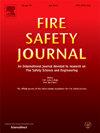Development of the Conditional Source-term Estimation (CSE) framework including finite-rate kinetics and non-prescribed radiation applied to a methanol pool fire
IF 3.4
3区 工程技术
Q2 ENGINEERING, CIVIL
引用次数: 0
Abstract
The objective of this paper is to assess the new developments of Conditional Source-term Estimation (CSE) framework with improved radiation modeling in large eddy simulation applied to a medium-scale methanol pool fire. Tabulated detailed chemistry is included. Radiation is treated in two ways. The first is the optically thin approximation neglecting absorption. The second is through solution of the radiative transfer equation to account for absorption. The weighted-sum of gray-gases model is included in both cases and turbulence–radiation interactions are accounted for. Predictions of the time-averaged and root mean square temperature and velocity profiles, are compared with the experimental measurements at several locations. On the centerline, time-averaged temperature predictions agree well with the experiments except close to the pool where the temperatures are underpredicted. The predicted radial profiles are close to the experiments. The centerline species concentrations show a general agreement in trends, but there are some discrepancies especially towards the downstream regions of the fire. Sources of discrepancy are discussed. Overall, the different treatments of radiation show comparable predictions, but larger benefits of the current CSE framework are expected for more complex scenarios.
Novelty and Significance Statement
The novelty of the present study is the development of a combined turbulent combustion modeling framework, Conditional Source-term Estimation (CSE), including detailed chemical kinetics with advanced radiation models through solution of the radiative transfer equation. In this paper, absorption effects are included in the radiative fluxes, the optically thin assumption is discussed and turbulence–radiation interactions are accounted for. Inclusion of these coupled thermo-chemical–physical phenomena within CSE and using conditional averages in the context of pool fire simulation is a significant contribution. A rigorous validation is performed for a well-documented medium-scale methanol pool fire. This study lays the foundations for more complex fire scenarios of different scales, fuels and conditions.
条件源项估计(CSE)框架的发展,包括有限速率动力学和应用于甲醇池火灾的非规定辐射
本文的目的是评估具有改进辐射模型的条件源项估计(CSE)框架在大涡模拟中应用于中等规模甲醇池火灾的新进展。表格详细的化学包括在内。辐射有两种治疗方法。第一种是忽略吸收的光学薄近似。第二种是通过求解辐射传递方程来考虑吸收。在这两种情况下都包括了灰色气体模型的加权和,并考虑了湍流-辐射相互作用。预测的时间平均和均方根温度和速度分布,与几个地点的实验测量结果进行了比较。在中心线上,时间平均温度预测与实验结果吻合得很好,只有靠近水池的地方温度被低估了。预测的径向分布与实验结果接近。中心线物种浓度在趋势上基本一致,但在火灾下游地区存在一些差异。讨论了差异的来源。总的来说,不同的辐射治疗显示出类似的预测,但目前的CSE框架预计将在更复杂的情况下带来更大的好处。新颖性和意义声明本研究的新颖性在于开发了一种结合湍流燃烧建模框架,即条件源项估计(CSE),通过求解辐射传递方程,包括详细的化学动力学和先进的辐射模型。本文将吸收效应纳入辐射通量,讨论了光薄假设,并考虑了湍流-辐射相互作用。在CSE中包含这些耦合的热化学物理现象,并在池火模拟的背景下使用条件平均是一个重要的贡献。一个严格的验证进行了充分记录的中型甲醇池火灾。这项研究为不同规模、燃料和条件下更复杂的火灾情景奠定了基础。
本文章由计算机程序翻译,如有差异,请以英文原文为准。
求助全文
约1分钟内获得全文
求助全文
来源期刊

Fire Safety Journal
工程技术-材料科学:综合
CiteScore
5.70
自引率
9.70%
发文量
153
审稿时长
60 days
期刊介绍:
Fire Safety Journal is the leading publication dealing with all aspects of fire safety engineering. Its scope is purposefully wide, as it is deemed important to encourage papers from all sources within this multidisciplinary subject, thus providing a forum for its further development as a distinct engineering discipline. This is an essential step towards gaining a status equal to that enjoyed by the other engineering disciplines.
 求助内容:
求助内容: 应助结果提醒方式:
应助结果提醒方式:


